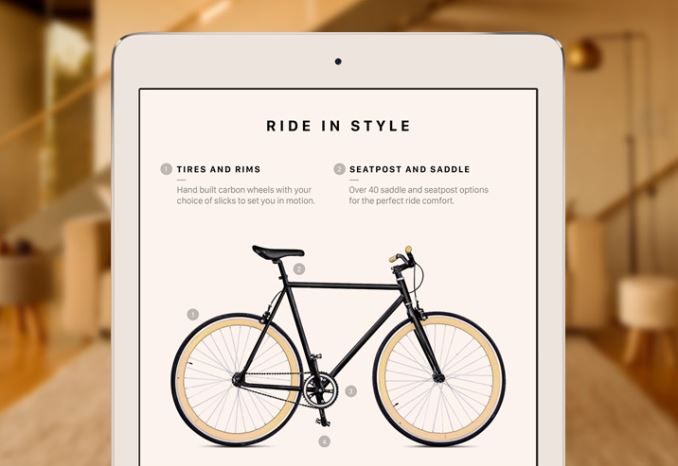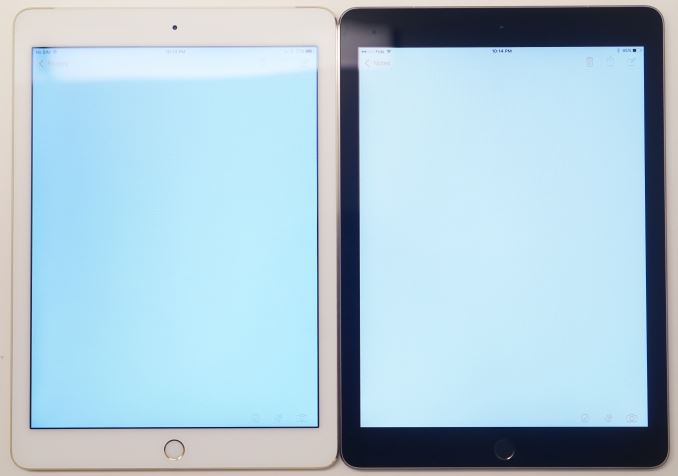The 9.7" iPad Pro Review
by Brandon Chester on June 1, 2016 9:00 AM ESTA Few Thoughts On True Tone
Back when I received the 9.7" iPad Pro I published some of my thoughts regarding the True Tone display technology. And while I won't really be going over the topic in great detail again, I do have some additional thoughts on the technology after having using the new iPad Pro for quite some time.
Something I wanted to clarify from my original article is the purpose of my greyscale measurements. Some readers interpreted it as evidence that True Tone didn't work as intended. In actuality True Tone works exactly as intended by providing good relative accuracy. As you move to different environments the color temperature of the display shifts to match how your eye adjusts its perception of white depending on the temperature and brightness of the light around you. This obviously leads to inaccuracy relative to the sRGB standard, but that's missing the point of True Tone entirely. My tests were simply meant to demonstrate how much shifting occurs in different environments, along with a clarification on some misunderstandings I had heard regarding the relationship between True Tone and the DCI-P3 gamut, which are really unrelated technologies.
True Tone works very well, and in a way Apple has proven me wrong here because I was initially skeptical. I've seen this attempted before, particularly by Samsung, and the implementations have not been good at all. When I first got the 9.7" Pro I felt like the True Tone mode shifted too far toward the red. However, after using it for some time I began to realize that this was the product of me using other devices that all shift toward blue, which ruined my perception of the display. When using the iPad Pro on its own for reading or doing work, pulling out another device with a blue shifted display is absolutely jarring, as the iPad has adjusted to match how my eyes perceive things in different lighting, while all my other displays are forever blue. In a way, the biggest problem with True Tone is that it's not in everything, and I think this is something Apple should be bringing to all of their portable devices.

Apple's Simulated True Tone Image
It's difficult to photograph True Tone, as depending on where your camera's white balance lands the iPad Pro will look too red, or the other display will look too blue. I really recommend checking out True Tone for yourself, although if you decide to do it in an Apple Store you probably won't see the benefits because Apple's other products are designed to look neutral under the same sort of fluorescent lighting as those stores. If you have a chance to try the 9.7" iPad Pro outdoors or somewhere with warmer lighting I think you'll see why this tech is one of the small things that nobody really asks for, but everyone appreciates once they have it.











144 Comments
View All Comments
digiguy - Friday, June 3, 2016 - link
What do you know? even core I7 has been made fanless in a 12 inch tablet with a new cooling solution, so I don't see why core M could not work well in 10 inches. Battery life will depend on the battery size, in the onda it's smaller than in ipad air 2 for instance, and it lasts around 4 hours, with a bigger one it could last more, but is definitely much more than the 1 hour you speculate about...erple2 - Sunday, June 5, 2016 - link
But then that's the point, isn't it? Throwing a honestly poorly designed 10" tablet as proof that you can get a good tavlet with Core M is not helping your argument. How good is the display? How are the touch apps? How well does the pen work? How heavy is it? How hot does it run? How long does it run on a charge? What about everything else that is tested? Honestly, there has to be a reason why the big players hasn't integrated a more powerful CPU into a small tablet.As a staunchly anti Apple person, I gave to co cede that Apple really does have the best tablet this generation. While the Pixel C comes close, the Pen is very well implemented. Surfaces are fine, but I find that when I want to do real work, I turn to my much more powerful laptop to do that.
melgross - Wednesday, June 1, 2016 - link
Neither Surface Pro display can match the display for this product. First of all those products were reviewed before this one came out, and secondly, they are both sRGB displays, with their resultant smaller color gamut.Also, the iPad Pro, either model beats the least expensive Surface Pro in performance, and that model costs as much, or more than the competing iPad.
I understand that your Microsoft products are second best in a number of ways. Get used to it.
jlabelle2 - Thursday, June 2, 2016 - link
Having a wider color gamut than sRGB is not universally an advantage. Without going into this discussion on how many (little) images are benefiting from that, even in a proper color managed workflow (and iOS seems to be quite good here), sharing and distributing images with wider color space than sRGB is often (most of the time) counterproductive if others 1/ do not have wide gamut screen (the majority), 2/ do not have applications / browser reading the embedded color space (the majority). As such, the interest is honestly quite limited. It does not hurt at all the iPad, on the contrary, but in real life this is not what will make such display stands above other sRGB gamut wide screens.And regarding the Surfaces and DisplayMate, read in details and you will see they are also praised equally :
"The Surface Pro 4 also has the most accurate on-screen colors of any Tablet display that we have ever measured"
"However, Microsoft has also taken an important initial step, with the Surface 3 providing its best Color Accuracy in typical indoor 300 lux ambient"
My point is that many tablets have just excellent screens and that the iPad Pro does not seem to stand in a class of its own at all. But what makes Surfaces screens a real treat for people that value color accuracy is being able to calibrate the screen. That is making all the difference.
Because LCD screen colors evolve unfortunately with time. It would be interesting that Brandon would test and iPad Air 2, today, used since the beginning and how it differs of the original out of the box measurement.
As such, if we are taking only this criteria, for designer or photo / video editor that value utmostly color accuracy, the non calibrating iPad display is a drawback. I mentioned this because making some photo editing on the wedding I shoot, I can clearly see that the iPad Air 2 I have is no match with the Surface Pro 3 I also have, once calibrated.
Meteor2 - Thursday, June 2, 2016 - link
Cor, you're angry.grayson_carr - Thursday, June 2, 2016 - link
You can compare the displays at the link below. Basically, the calibrations are on par out of the box, with the iPad having a slightly better calibrated white point. The iPad has MUCH higher max brightness and a higher color gamut. The Surface Pro 4 has slightly better contrast and like you said, the ability to do your own calibration. Out of the box I would say the iPad Pro has the slight edge with the higher brightness, higher color gamut, and true tone feature. But the Surface Pro 4 display might be better for professionals down the road with the ability to recalibrate it.http://www.anandtech.com/bench/product/1697?vs=157...
nikon133 - Thursday, June 2, 2016 - link
Performance... in what scenarios? Only if there are pro apps to take advantage of that power, does performance have any meaning. Right now, iPad Pro's "power" is only good for rubbing it into others' faces over a cup of coffee. Once these babies are put to use, iPP turns out just faster iPad, but far cry from Pro device. In real life, it is just an iPad that will turn iBook pages faster, do smoother fly-overs in Apple Maps. Have Apple decided to call it iPad Air 3, no-one would know the difference.I'm finding it ironical that, for ecosystem (and fans) insisting on quality and quantity of casual apps in library, suddenly lack of apps in Pro segment is being ignored or played down. One can't do much on it, but look, oooh, it is so fast.
iPad Pro can be twice as fast as i7 Surface... but without tools from Adobe, Corel, Audodesk... even full-blown Office suite... how is it better Pro tablet than any x86 device?
Re pricing. I cannot compare 32GB iPP with 128GB SP. Much as prices go here in NZ - might differ where you are - 128GB 9.7" iPP is NZ$1,329.00, plus NZ$189 for pen. That makes NZ$1,518, compared to $1,439 for 128GB mCore SP4, which comes with pen. Even if we ignore that these are prices from Apple's and MS's web stores and that SP can be found even cheaper in shops, while iPP basically can't... even if we stick to these prices... you are saying that more expensive device with smaller screen, crippled multitasking, no real library of pro software, no easy (or any, in some cases) way to dock it, connect it to multiple desktop screens, wired network, USB devices... is somehow better device just because it cranked out better score in some synthetic benchmarks..?
OK...
Lochheart - Friday, June 3, 2016 - link
Yes, the Surface can run Adobe, Corel, Autodesk... etc...Do you think anyone will buy a Surface when it need to work on Adobe tools ? It will never happen.
Who work on a 12" screen ? My 15" Laptop is already to small... So yes, a Surface can run lot of stuff... but compare to what we have on PC side, it's just a outdated config overhype.
jlabelle2 - Tuesday, June 14, 2016 - link
"Do you think anyone will buy a Surface when it need to work on Adobe tools ? It will never happen."I do. This is why I replaced my iPad (my wife is still using her iPad Air 2 for casual stuff) with a SP3 and gave my desktop to my kids. I am using the SP3 as a tablet in the bed, train, airplane for media consumption and tablet things, I am attaching the keyboard when I want to type things, but I can also develop my RAW files in the train with Capture One Pro (alternative from Adobe Lightroom) or in the bed in tablet mode. And 12" is plenty enough to work on pictures as the screen is high resolution and you can easily pinch to zoom.
Or I can simply dock it and use it with a calibrated 27" monitor / keyboard and mouse. That is THE point of using a Surface. Doing more than an iPad.
"but compare to what we have on PC side"
It IS a PC. Also. It replaces basically the need for a PC for 98% of the people.
mrochester - Wednesday, June 1, 2016 - link
I see you post in a similar vain here as you do on the Verge forums!